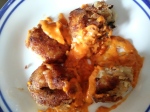After the sweetness of the past few days I wanted to try something different. The title of this recipe Irish Turbet has intrigued me from the beginning since I’m not sure why it is considered Irish and I don’t know anything about Turbet. The main ingredient in this Berlin Cook Book (1906) recipe contributed by Mrs. Honsberger is canned salmon. You’ll also need some milk, onion, butter, flour, eggs, salt & pepper and some biscuit crumbs.
I know that salmon came in larger cans in 1906 but I had the typical size we find in grocery stores today. I confess I’m not a fan of salmon but bought the can to use in recipes like this. I probably should have made half the sauce but I went ahead and made the entire “cream” as Mrs. Honsberger calls her mixture. I opened my can of salmon and discovered there weren’t any bones or skin like I remember from years ago so no picking required.
Next I put two cups (1 pint) of skim milk in a saucepan and added half an onion chopped in pieces. I heated the milk and made the decision to leave the onion pieces in the milk. I’m sure Mrs. Honsberger has her reasons for this rather wasteful practice but since I like onions a lot more than salmon I thought at least I’d be able to eat part of the completed product.
 So on to the next step. Is it half a cup of butter before or after melting? I split the difference and measured out slightly more than half a cup of butter and melted it. I poured it into the oniony milk. I was supposed to add four tablespoons of flour but I’d forgotten that I still didn’t have any handy. I have a giant bag of flour but it is sitting in another part of the house waiting to be moved to the kitchen. Instead I had a small bag of buckwheat flour sitting nearby. I’d already gone rogue with this recipe so I decided to use it. After all buckwheat and salmon might go together rather well … won’t they? I cooked the mixture until it thickened and then set it aside to cool. I added salt and pepper at this point. It already looked like it contained pepper but that was from the buckwheat flour.
So on to the next step. Is it half a cup of butter before or after melting? I split the difference and measured out slightly more than half a cup of butter and melted it. I poured it into the oniony milk. I was supposed to add four tablespoons of flour but I’d forgotten that I still didn’t have any handy. I have a giant bag of flour but it is sitting in another part of the house waiting to be moved to the kitchen. Instead I had a small bag of buckwheat flour sitting nearby. I’d already gone rogue with this recipe so I decided to use it. After all buckwheat and salmon might go together rather well … won’t they? I cooked the mixture until it thickened and then set it aside to cool. I added salt and pepper at this point. It already looked like it contained pepper but that was from the buckwheat flour.
I really really wanted to skip the eggs. Long time readers of this blog know I really hate eggs. I don’t like their texture or their taste. By adding them to this nicely tasting if oddly coloured mixture was I dooming it to the green bin? I decided to follow the recipe and added two beaten eggs once the mixture was cooler. They blended in nicely. It was time to assemble my Irish Turbet.
I poured have the creamy mixture into a casserole dish and then put the bits of salmon on top. I poured the rest of the cream on top. I didn’t have any biscuits which I assumed meant what we call biscuits rather than the British cookie type biscuit but I did have some dried out quick bread I’d made last week for a video at work. It’s slightly sweet so I thought it might suit. I sprinkled bits of this bread over the top and put it in the oven. I’d preheated to 300 F, since the recipe calls for a slow oven. I left it for 30 minutes.
I was able to pass the time with a social distancing visit. My best friend was dog walking and let me know she was outside. We talked from the sidewalk and porch. It was so nice to see someone in person rather than on a screen or as a voice on the phone even if we were metres apart. And when I went back to my oven it was almost time to take out the Irish Turbet. It smelled good. I removed it from the oven and scooped out a portion to have for supper.
Mrs. Honsberger is probably Alberta C. Stoddard. She was born in Norfolk County, Ontario in July 1867. Her father was an agricultural implement dealer. She married Dr. Jerome F. Honsberger in 1890 when she was 23. Their first little girl Rhea died of scarlet fever when she was two. Shortly afterwards they moved to Berlin where their son Gordon was born and a few years later daughter Nina arrived.
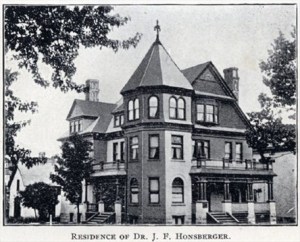 The 1901 census shows a busy household. Not only is there 32-year-old Alberta and Jerome (41) but there is infant Nina and 4-year-old Gordon plus Jerome’s brother Henry plus a 28-year-old lodger named John and a 22-year-old domestic servant named Mary. They are all of German heritage except Mrs. Honsberger who is Scottish. The lodger is a bookkeeper and the brother is a commercial teacher. In the 1911 census the brother and lodger are gone from the household at 97 Frederick street but there is still a maid. You can find out more about the family and their home in this article in the Record. Their home still exits.
The 1901 census shows a busy household. Not only is there 32-year-old Alberta and Jerome (41) but there is infant Nina and 4-year-old Gordon plus Jerome’s brother Henry plus a 28-year-old lodger named John and a 22-year-old domestic servant named Mary. They are all of German heritage except Mrs. Honsberger who is Scottish. The lodger is a bookkeeper and the brother is a commercial teacher. In the 1911 census the brother and lodger are gone from the household at 97 Frederick street but there is still a maid. You can find out more about the family and their home in this article in the Record. Their home still exits.
And what about that recipe title? Well I suspect it is supposed to be spelled Turbot. That’s a kind of flatfish. As to why it’s Irish perhaps it’s related to Scots and Irish issues. This is one of those dishes that falls into the “mock” category. It uses something easily available and relatively cheap for something harder to acquire and probably more expensive. Considering the Honsberger household in 1906 likely included the brother and boarder as well as two growing children, this dish would be a good choice.
 Wow! I like Irish Turbet (or Turbot). This reminds me of tuna casserole minus the noodles. I like tuna casserole so that means it’s good. In fact tomorrow I might just cook some noodles and add them since my salmon is swimming in sauce. If you make this either half the sauce or double the salmon. Add two cans to equal the 1906 size. Although Mrs. Honsberger preferred onion flavoured sauce rather than actual onions, I’m glad I made the decision to keep them in the mix. My big surprise is that the buckwheat flour is a good substitution. It tastes good and adds an interesting look to the sauce. After all much of Eastern Europe eat buckwheat and salmon. I’d probably use regular bread crumbs next time. Although the sweet taste of mine were okay, plain would be better and they will be crispier. This recipe has time travelled to pandemic 2020 rather well and gives lots of scope for modern cooks to make it their own.
Wow! I like Irish Turbet (or Turbot). This reminds me of tuna casserole minus the noodles. I like tuna casserole so that means it’s good. In fact tomorrow I might just cook some noodles and add them since my salmon is swimming in sauce. If you make this either half the sauce or double the salmon. Add two cans to equal the 1906 size. Although Mrs. Honsberger preferred onion flavoured sauce rather than actual onions, I’m glad I made the decision to keep them in the mix. My big surprise is that the buckwheat flour is a good substitution. It tastes good and adds an interesting look to the sauce. After all much of Eastern Europe eat buckwheat and salmon. I’d probably use regular bread crumbs next time. Although the sweet taste of mine were okay, plain would be better and they will be crispier. This recipe has time travelled to pandemic 2020 rather well and gives lots of scope for modern cooks to make it their own.
IRISH TURBET
Mrs. Honsberger
1 can of salmon, pour off liquid and remove bones, heat one pint of milk with a few pieces of onion, skim out onion, then add 1/2 cup of melted butter, four tablespoons flour, season with salt and pepper, when cool add two eggs well beaten, put layer of cream, then layer of salmon, then cream, sprinkle biscuit crumbs on top, bake in a slow oven half an hour.


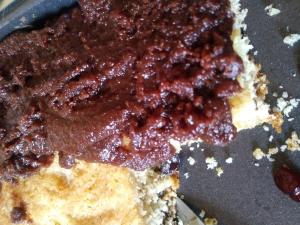
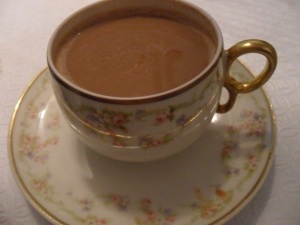
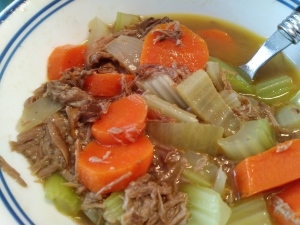


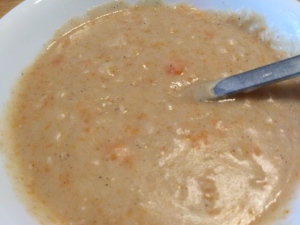

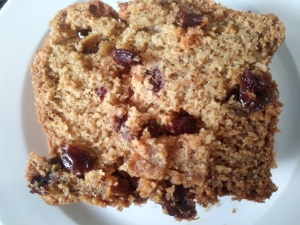
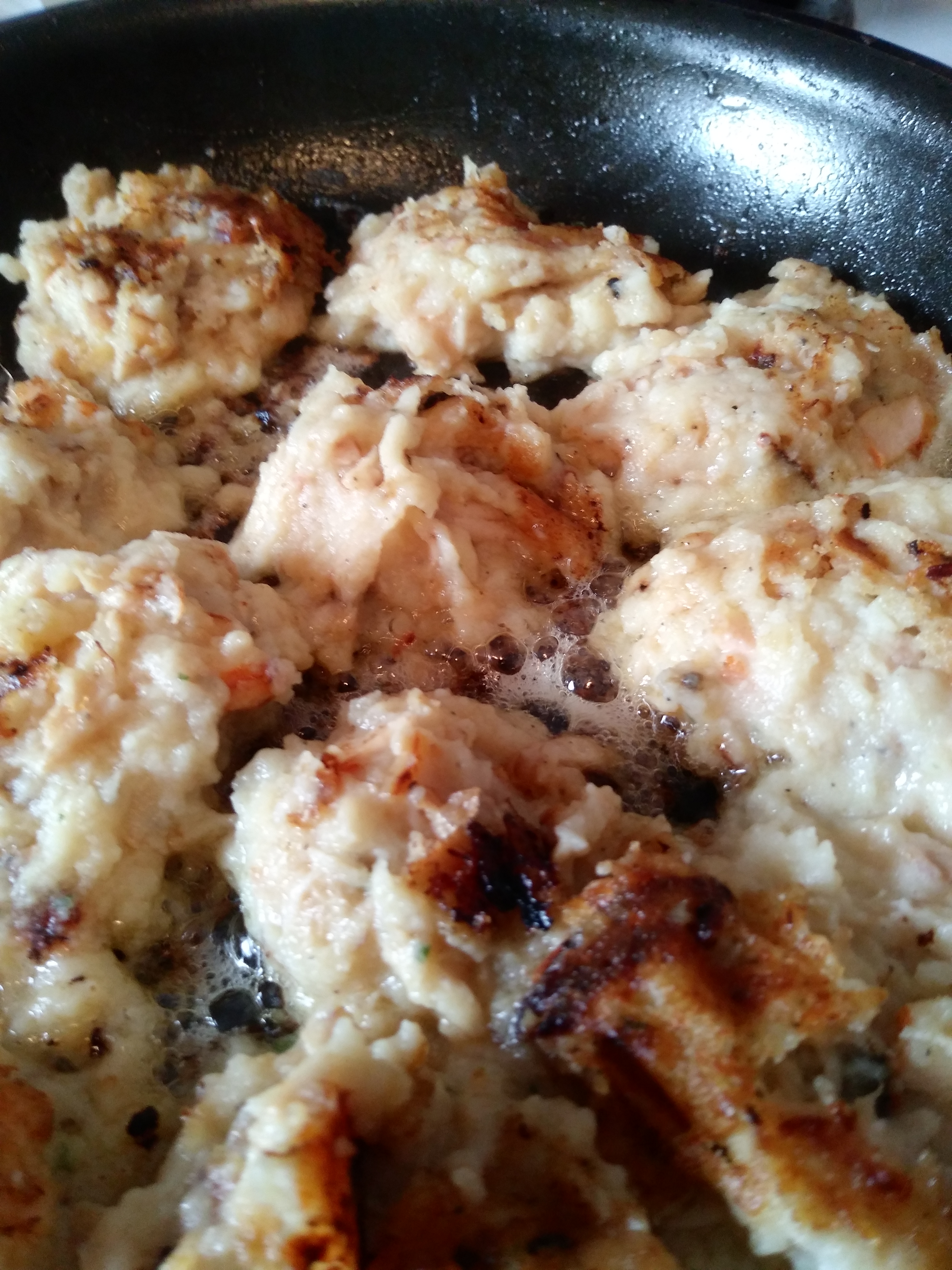 What size should I make the meat balls? I decided to experiment with a tablespoon of the mixture and making one smaller and one larger. The mixture was quite moist so the balls were a bit blobby. Once I had an array of meat balls ready, I heated the frying pan. But should I add some fat to the pan? I decided to add a tablespoon of butter and put all the balls in the pan. As they started to get browned on one side I turned them over. I soon realized I’d added a bit too much fat to the pan but eventually they were all browned.
What size should I make the meat balls? I decided to experiment with a tablespoon of the mixture and making one smaller and one larger. The mixture was quite moist so the balls were a bit blobby. Once I had an array of meat balls ready, I heated the frying pan. But should I add some fat to the pan? I decided to add a tablespoon of butter and put all the balls in the pan. As they started to get browned on one side I turned them over. I soon realized I’d added a bit too much fat to the pan but eventually they were all browned.